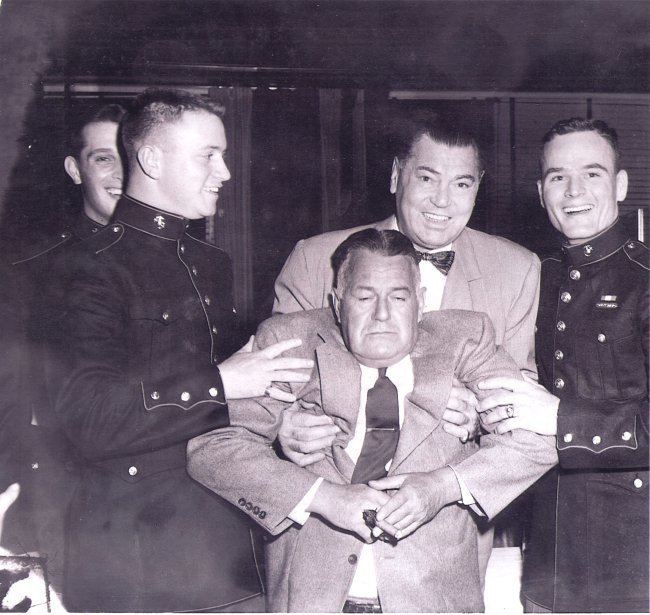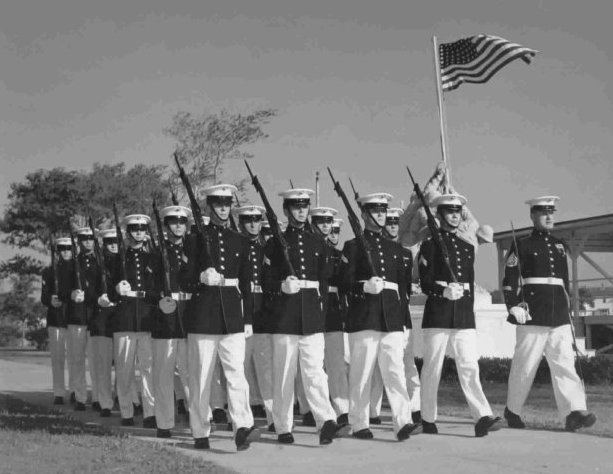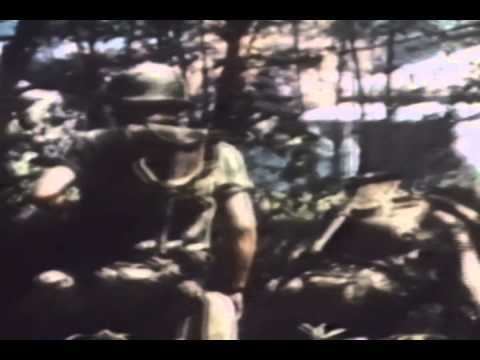Start date April 8, 1956 | ||
 | ||
Similar Lee Mirecki incident, Jason Rother incident, Kurkse tragedy | ||
Beaufort history moment ribbon creek incident
The Ribbon Creek incident occurred on the night of April 8, 1956, when Staff Sergeant Matthew McKeon, a junior drill instructor at the Marine Corps Recruit Depot Parris Island, South Carolina, marched his assigned Platoon into Ribbon Creek, a swampy tidal creek. The incident resulted in the deaths of six US Marine Corps recruits. McKeon was found guilty of possession and use of alcoholic beverage.
Contents
- Beaufort history moment ribbon creek incident
- Incident
- Investigation
- Consequences
- Public opinion and media coverage
- References
Incident

On April 8, 1956, at approximately 8 P.M., Staff Sergeant Matthew McKeon, a combat veteran of World War II and the Korean War, led Platoon 71, his assigned platoon of 74 recruits, on an extra exercise to Ribbon Creek. It was proven during the trial that Staff Sergeant McKeon was not intoxicated or under the influence of alcohol at the Time of the exercise. McKeon led the platoon toward a swampy tidal creek on Parris Island, near the Marine Corps recruit depot and conducted an exercise in the Creek. McKeon entered the water first. The recruits were joking and fooling around in the water. The recruits broke formation as they entered the creek into the swamps adjacent to the Weapons Training Battalion on April 8, 1956. The platoon marched along the creek bed and some into deeper water. Some of the men could not swim, however, and six drowned during the incident: Private Thomas Curtis Hardeman, 1587021; Private First Class Donald Francis O’Shea, 1550900; Private Charles Francis Reilly, 1566628; Private Jerry Lamonte Thomas, 1585496; Private Leroy Thompson, 1590031; and Private Norman Alfred Wood, 1590034.
Investigation
Between 9:00 P.M. and 9:20 P.M. Captain Patrick called Colonel W.B. McKean, USMC the Commanding Officer of Weapons Training Battalion, Marine Corps Recruit Depot, Parris Island South Carolina. Captain Patrick reported: "We're in trouble. There are a bunch of recruits coming back to building 761 and it seems that the DI has been marching them through the swamps. I'm going down now to investigate it." Colonel McKean, without knowing more, responded: "Lock up the DI. Send to sickbay those that need it. Get the rest of them policed up and call me back as soon as you know the number of that platoon and the battalion." On Monday April 9, 1956 a Court of Inquiry was convened to inquire into the circumstances surrounding the marching of platoon 71 into Ribbon Creek. The proceedings began on April 10, 1956. Sergeant McKeon was initially represented by a Marine Corps attorney but on April 14, 1956, his brother in law, Thomas P. Costello stepped into the case to defend Sergeant McKeon. Mr. Costello was assisted by another New York lawyer, Jim McGarry and Lt. Jeremiah Collins, the appointed Marine Corps counsel. There was no specific prohibition against entering the creek, as noted Colonel McKean in his memoir, Brigadier General William B. McKean, Ribbon Creek When asked by counsel for the defense, Mr. Costello, whether there were any orders that prohibited using the marshes and swamp areas for training exercises, Colonel McKean answered: "....To the best of my knowledge the only order that relates to swamps has to do with marching down around the area of Elliot's Beach..." During the Court of Inquiry proceedings Mr. Costello asserted that night marches were common exercises. In his memoir, Ribbon Creek at p. 228, Colonel McKean wrote that General "Burger's efforts to deny the practice of night marches into swamps becomes ludicrous when we analyze the argument of his ghost writer, Major Faw." id. Colonel McKean confirmed this practice by inquiring of approximately eighteen Marines assisting in the search of Ribbon Creek on April 10, 1956 whether any had marched at night into the swamps. The answer was a "clear majority."

The Court of Inquiry resulted in four charges including having alcohol on base arising from Sergeant McKeon's participation in a drink on base at approximately noon, as well as the more serious charges of oppression of troops and involuntary manslaughter. He was also charged with drinking in front of a recruit but was acquitted of that charge and the other more serious charges but was found responsible for negligent homicide based upon simple negligence after the court martial.

McKeon was brought to a court of inquiry directly on the following day. At first, he was classified mentally and "emotionally stable" and "a mature, stable appearing career Marine." Later, the Court of Inquiry found that the detailed directives regarding and prohibiting certain Marine training methods were "correct and adequate" and that McKeon had launched an unnecessary and unauthorized disciplinary action. It was revealed that McKeon had consumed a few alcoholic beverages the afternoon before the evening of the march but was determined that he was not under the influence of alcohol as he led the recruits into the water.
It was recommended for McKeon to be court-martialled.
Consequences
McKeon was brought to court martial amidst a howl of public condemnation about the "brutality" of Marine Corps training. Many Marines came to McKeon's defense by pointing out such training was necessary for survival in combat. McKeon's supervisor, Staff Sergeant E. H. Huff, testified in his defense. He called McKeon an outstanding drill instructor and said that night marches were very common on Parris Island. He said the discipline in the platoon was so poor that he would have taken the recruits on the march himself if he had had the time.
McKeon was defended by a group of volunteer lawyers from New York City including his brother in law, Thomas P. Costello, Emile Zola Berman and Howard Lester as well as Marine Corps attorneys, Lieutenant Colonel Alaric W. Valentin, Major John R. DeBarr and Lieutenant Collins. Emile Zola Berman was the lead counsel. He was a distinguished and successful trial attorney, specializing in negligence cases but he was also dedicated to preserving the constitutional rights of the criminally accused. In addition to representing Sergeant McKeon, he presented a successful criminal defense in 1964 in Alexandria, La. of a 14 year old African American boy charged with rape. He joined the defense team for Sirhan Sirhan when asked to do so, also as a volunteer and without compensation.
McKeon was defended by colorful civilian attorney Emile Zola Berman, who would later go on to defend Sirhan Sirhan. Berman put on a vigorous defense that swayed both the court and public opinion. Marine Corps Commandant General Randolph Pate testified. One reporter pointed out this was like "calling J. Edgar Hoover to testify about a problem within the FBI". The trial's most dramatic moment, however, was the arrival of General Lewis "Chesty" Puller, the most decorated Marine in the history of the Corps. Berman called Puller to testify about training methods. Puller called the incident in Ribbon Creek "a deplorable accident" but one that did not warrant court martial. He said that discipline was the most important factor in military training. He quoted Napoleon in saying that an army becomes a "mob" without it. He mentioned his experiences in the Korean War and that one of the reasons troops failed was because of lack of night training. General Puller felt that the press had blown the incident out of proportion because of prejudice they had against the Marine Corps. He mentioned a similar accident at an Army post in which ten soldiers drowned and pointed out that none of their superiors had been charged and that it had never made headlines the way Ribbon Creek did.
In the end, McKeon was acquitted of manslaughter and oppression of troops. He was found guilty of negligent homicide and drinking on duty. The Secretary of the Navy, Charles S. Thomas, wrote in his final action on the case that "The members of the court-martial, acting in their capacity of the equivalent to jurors in civil courts, acquitted the accused not only of all intentional or willful misconduct toward the men under his command, but acquitted him also of 'culpable' negligence with respect to the loss of life. if the accused had been found guilty of either of these two much more serious types of misconduct, i.e., 'oppression' or 'culpable' negligence, a reduction in the sentence would not be deserved, and would condone such serious misconduct. on the basis of the court's findings, however, this case presents to me the problem of adjudging an appropriate sentence for 'simple' negligence, which is not generally regarded by law or society as nearly so blameworthy as the much more serious types of misconduct classified as culpable negligence or intentional misconduct......Simple negligence is not 'bad conduct' in the normal meaning of the term 'bad', nor in the military connotation of that term. a bad conduct discharge therefore appears inappropriate in that respect. " in reducing the sentence and allowing Sergeant McKeon to stay in the Corps, Secretary Thomas asked if a bad conduct discharge was appropriate "under the circumstances of the principal offense for which he was convicted, which is negligent homicide based upon simple negligence." Secretary Thomas further noted the following : "There is no question in my mind that his entire record prior to 8 April 1956 indicated that Sergeant McKeon was a capable non-commissioned officer, dedicated to the United States Marine Corps. More than that, the testimony pictures him as a good man, sincere, and of a sympathetic nature. He has always attended church regularly. Even though he was relatively inexperienced as a drill instructor, his general reputation was excellent. I could not help but be impressed how recruit after recruit, who were in his platoon, who had followed him on that fatal night march, testified concerning his character. They were initially prosecution witnesses, and their testimony had the ring of sincerity. All of them, college men and men with little schooling, described him as a 'very patient man', an 'extremely patient man'. A number of them stated he helped them with their personal problems. he was always ready to give his recruits 'the breaks'. I, in my mind, am sure that Sergeant McKeon never meant to harm his men. I am convinced that a punitive separation from the service is not necessary as punishment for this man, nor would the interests of the Marine Corps be served by such a separation. For him I believe that the real punishment will be always the memory of Ribbon Creek on Sunday night, April 8, 1956. Remorse will never leave him....He may be expected to appreciate the feelings of those whose sons were lost that fateful night. His conduct immediately following the loss, and the spontaneous statements he made at the time, speak eloquently of remorse. For all the foregoing reasons, I have determined that the bad conduct discharge should be remitted." Thus the Secretary of the Navy reduced the sentence, remitted the bad conduct discharge and allowed Sergeant McKeon to remain in the Corps with a reduced rank to private. Prior to the reduction by Secretary Thomas, the sentence was a $270 fine, 9 months of confinement at hard labor, rank reduced to private and a bad conduct discharge.
The Secretary of the Navy later reduced the sentence to three months in the brig, reduction to private with no discharge and no fine. McKeon went back on active duty. He was never able to regain his former rank and was medically retired from the Marine Corps in 1959 as a corporal by claiming a back injury. He worked as an inspector of standards for his home state of Massachusetts. In a 1970 Newsweek interview, he talked of his lifelong burden of guilt and how he prayed to God every day to keep the boys in his safekeeping and for forgiveness. Matthew McKeon died on November 11, 2003, at the age of 79.
John C. Stevens wrote a book about the Ribbon Creek incident called Court Martial At Parris Island. He tracked down and interviewed many of McKeon's recruits. Stevens pointed out that with one exception, all of them spoke in favorable terms about their former drill instructor. They claimed he was not the sadist portrayed by the prosecution.
Marie Costello Inserra, daughter of Thomas P. Costello and an attorney admitted to practice law in New York since 1988 and North Carolina since 2006, also wrote a book about the incident and the defense case entitled: Counsel for the Accused Marine Corps Drill Sergeant. It is largely based upon the transcripts of the court of inquiry, the trial, the diary of Thomas P. Costello and conversations with Thomas P. Costello.
The incident led to several changes in Marine Corps recruit training, following reforms that had begun in the early 1950s, in the wake of the Korean War and a large influx of recruits into the Corps. Recruit Training Commands, commanded by Brigadier Generals directly appointed by and answering to the Commandant, was established aboard both Parris Island and MCRD San Diego. Within the commands, officers were selected to oversee recruit training down to the Series level. New Drill Instructor schools were established within each command, and DIs were more carefully selected. The number of Drill Instructors assigned to each platoon was expanded to three, rather than two, and the role of the Drill Instructor was reformed to emphasize example, leadership, persuasion and psychology in the process of recruit training. Special Training Company was also established to provide remedial training to recruits needing additional physical conditioning, motivation, or education and rehabilitation to recruits suffering from medical conditions. The campaign cover was introduced as a distinctive element of Drill Instructor dress, in part to recognize a new norm of professionalism and specialization within the Drill Instructor billet and also to signify a break from the "old" era of recruit training and the "new." The changes in Marine Corps training that occurred as a result of the Ribbon Creek tragedy are documented in a historical analysis written by Keith Fleming entitled: The U.S. Marine Corps in Crisis Ribbon Creek and Recruit Training, University of South Carolina Press, 1990.
Public opinion and media coverage
The incident was the subject of significant media coverage. Several publications, including Time Magazine reported thoroughly on the development of the trial. The trial was covered by every national and many local newspapers. Jim Bishop, a syndicated columnist and accomplished author of such well known books as "The Day Lincoln was Shot" and "A Day in the Life of President Kennedy" among many others, also wrote extensively in his syndicated column about the entire trial and the Marine Corps. Jim Bishop's columns on this trial and other significant events that he covered appear in a collection entitled: Jim Bishop: Reporter by Jim Bishop, Random House 1966.
Additionally, the US Congress launched its own investigation. The 1957 film The D.I., directed and starring Jack Webb as the title character, may have been made to provide the US Marine Corps's view on the need for high pressure basic training. The film was written by James Lee Barrett and based on his teleplay for Kraft Television Theatre, Death of a Sand Flea.
